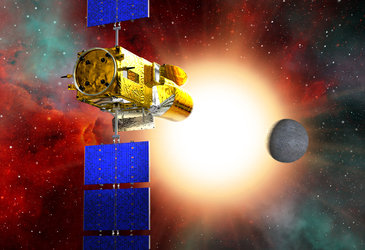

Science & Exploration
Artist's view of the COROT satellite
Artist’s view of COROT, the exoplanet hunter mission led by CNES, with ESA participation. Due for launch at the end of 2006, COROT will be placed on a circular, polar orbit around Earth that will allow for continuous observations of two large and opposite regions in the sky for more than 150 days each.
COROT will use its telescope to monitor closely the changes in a star’s brightness that comes from a planet crossing in front of it. While it is looking at a star, COROT will also be able to detect ‘starquakes’, acoustical waves generated deep inside a star that send ripples across a star’s surface, altering its brightness. The exact nature of the ripples allows astronomers to calculate the star's precise mass, age and chemical composition.





